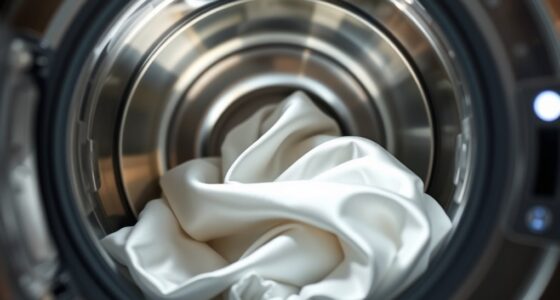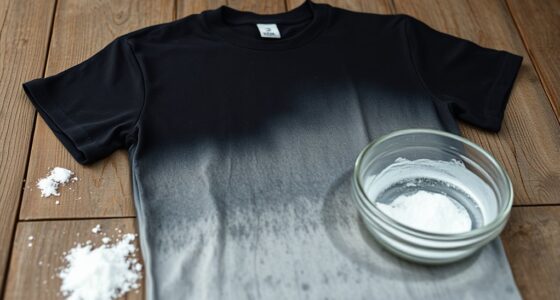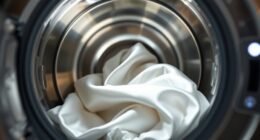To cut your water use in half without sacrificing clean clothes, run full loads and select water-efficient settings on your washing machine. Use cold water for most cycles, and pre-treat stains to reduce wash frequency. Switch to eco-friendly or plant-based detergents that require less rinsing. Regularly maintain your appliances for peak performance. Keep these tips in mind, as there are more simple changes that can make your laundry routine both eco-friendly and effective.
Key Takeaways
- Always run full loads to maximize water efficiency and prevent waste.
- Use high-efficiency washing machines with water-saving settings for optimal conservation.
- Opt for cold water washes paired with eco-friendly detergents to reduce energy and water use.
- Pre-treat stains to minimize the need for multiple washes, saving water and resources.
- Select shorter or eco-cycle options on your machine to cut water consumption without losing cleaning power.

Have you ever wondered how your laundry routine impacts the environment? Every wash consumes water, energy, and often involves harsh chemicals that can harm ecosystems. But the good news is, you can make a difference without sacrificing the cleanliness of your clothes. One effective way is by exploring detergent alternatives and paying attention to your washing machine efficiency. Switching to eco-friendly detergents or natural cleaning options can considerably reduce the amount of chemical runoff and water used during each cycle. These alternatives often require less water to rinse out, which means you can cut down on water consumption without losing cleaning power. Additionally, choosing detergents with plant-based ingredients or biodegradable formulas helps minimize environmental impact.
Improving your washing machine efficiency is another essential step. Modern models tend to use less water and energy, especially if they come with eco or water-saving settings. If you’re still using an older machine, consider upgrading, as newer appliances are designed to maximize efficiency. But if an upgrade isn’t feasible right now, you can still optimize your current machine by always running full loads—this guarantees you’re making the most of each wash cycle. Also, selecting shorter wash cycles when your laundry isn’t heavily soiled can save both water and energy, making each load more eco-friendly.
Another tip is to adjust the water level manually if your machine allows it. Many older or basic models enable you to set the water level based on load size, preventing unnecessary water use. Moreover, pre-treating stains or heavily soiled clothes can reduce the need for multiple washes, saving resources over time. Using cold water for most loads is also a simple yet effective way to decrease energy consumption since heating water accounts for a large portion of laundry energy use. Cold washes paired with detergent alternatives designed for low temperatures can still deliver excellent cleaning results. Additionally, selecting a high-efficiency washing machine can significantly improve water and energy savings over time.
Frequently Asked Questions
How Can I Tell if My Laundry Detergent Is Eco-Friendly?
To tell if your laundry detergent is eco-friendly, check its ingredients for natural, biodegradable components and avoid harsh chemicals. Look for eco label certifications like EPA Safer Choice or USDA Organic, which indicate it meets strict environmental standards. These labels help you identify products that are safer for the environment, water, and your family, ensuring you choose a detergent that aligns with eco-friendly laundry practices.
Are There Specific Washing Machine Settings to Reduce Water Use?
Imagine your washing machine as a skilled artist, adjusting machine cycle adjustments to save water. You can select eco or water-saving modes, which automatically lower water level settings. Opt for shorter cycles and cold water washes when possible. These simple machine cycle adjustments help you cut water use in half, keeping your clothes fresh without wasting resources—proving that smart choices make a big difference for the environment.
Can I Use Alternative Natural Cleaning Agents Effectively?
You can definitely use alternative natural cleaning agents effectively. Plant-based detergents work well to clean your clothes without harsh chemicals, and vinegar cleaning helps remove odors and brighten fabrics. Just use the right amount, and you’ll find your laundry stays fresh and clean. These natural options are eco-friendly, cost-effective, and gentle on your skin, making them a smart choice for sustainable laundry routines.
How Often Should I Wash Clothes to Save Water?
You should wash your clothes only when necessary to extend their lifespan and reduce water use. Over-laundering can shorten clothing lifespan and waste resources, so consider laundry frequency based on how often you wear items and their dirtiness. Spot clean when possible, and air out clothes to keep them fresh. This way, you save water without sacrificing cleanliness, helping both your wardrobe and the environment.
What Are the Best Practices for Drying Clothes Sustainably?
You can dry clothes sustainably by exploring clothesline alternatives like indoor drying racks or using a retractable clothesline outdoors. Eco-friendly drying tips include air drying whenever possible, avoiding high heat settings, and spinning clothes thoroughly before drying to reduce time. These practices save energy, cut down on electricity use, and help protect the environment while keeping your clothes fresh and clean.
Conclusion
By adopting eco-friendly laundry habits, you not only cut water use in half but also discover how easy it is to make a difference. It’s a small change that surprisingly leads to big impacts — from saving the planet to saving your water bill. Who would’ve thought that a simple switch in your laundry routine could align perfectly with your eco-conscious goals? Now, every wash becomes a step toward a cleaner Earth, just like you intended.









